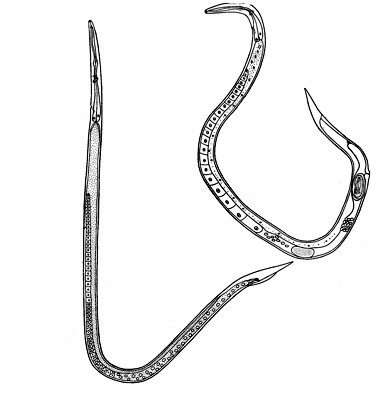Pests
Ditylenchus dipsaci Kuhn - Stem and Bulb Nematode (onion and garlic race)
Systematic position.
Phylum Nematoda, class Secernentea, order Tylenchida, suborder Tylenchina, superfamily Anguinoidea, family Anguinidae, genus DitylenchusBiological group.
Obligate parasite.Morphology and biology.
Eggs are oval; larvae of 1-4 instars, females and males are vermiform. Average body size is 1.5 x 0.03 mm in females, 1.3 x 0.025 mm in males. The nematodes penetrate into plants from either soil (larvae of 4 instar) or infested planting bulbs, rarely from seeds. They live between parenchymal cells of onion (garlic) leaves and between bulb scales, where they feed on cell sap and multiplicate. The female fecundity is 250 eggs during a season; 6 generations develop under optimum conditions; i.e., the temperature 15-20°C at sufficient humidity. As a result, the infested plant accumulates a large number of nematode worms. The visual symptoms of damage appear; onion leaves start to curve, garlic leaves become yellow and die. Bulb scales are loosened, bulb stems are cracked. The nematode development continues in infested bulbs during storage. The Stem and Bulb Nematode of onion and garlic race is a polyphage. Its plant hosts are peas, beetroot, vegetable marrow, pumpkin, rhubarb, and bulb ornamentals, and weeds such as Stellaria media, Linaria vulgaris, Polygonum aviculare, Fallopia convolvulus, Galium aparine. Grain crops are not affected by this nematode.Distribution.
Onion and garlic race of D. dipsaci is distributed in many countries of Europe with moderate climate, as well as in the USA and Canada. This species is registered in India, Brazil. In the former USSR, this nematode is widely distributed in Ukraine, Moldova, Georgia, Armenia, Azerbaijan, Kazakhstan, Uzbekistan, Kyrgyzstan. In Russia, it is found in the northern territories (being ubiquitous in 29 administrative districts of Murmansk and Leningrad Regions), in all zones of onion growing within the European part of the country, as well as in South Siberia and Primorskii Territory.Ecology.
This species, including its onion and garlic race, is ecologically flexible because of the combination of its polyphagy and the ability to anabiosis under unfavorable abiotic conditions. These features allow the onion and garlic race to occupy a broad area in the zone of onion and garlic growing in northern, middle, and southern latitudes. Nevertheless, the better development of the nematode is observed in regions with moderate climate, where the sufficient air humidity is combined with the prolonged period of optimum temperatures (15-20°C). Such conditions favor the highest female fecundity (250 eggs) and maximal number (6) of generations. In turn, the latter causes high severity of the nematodes, especially on heavy soils.Economic significance.
If the onion and garlic plants are infested from soil, the economic threshold amounts to 10 larvae per 500 cubic cm of soil in spring before planting of bulbs (seeds). The yield is sometimes half decreased under the ditylenchosis distribution 40%. Large yield losses may occur during storage of bulbs. To reduce the severity of D. dipsaci, the complex of measures is necessary, such as decreasing pre-planting soil infestation by growing of unaffected preceding plants (grain crops), rejection of diseased bulbs at sorting, thermotherapy of planting material, and use of systemic nematicides in seed production, if possible.Reference citations:
Amirkhanov M.I., Bereznyakova E.M., Rukhlyadev D.P. 1965. To investigation of plant nematodes in Dagestan. In: Ershov V.S., ed. Proc. scientific conf. of All-Union Helminthological Society. Moscow: AN SSSR. P.5 (in Russian).Dekker H. 1972. Plant nematodes and their control. Moscow: Kolos. 433 p. (in Russian).
Ivanova I.V. 1972. Investigation of susceptibility of some agricultural crops to stem nematodes of potato and onion. PhD Thesis. Moscow: VIGIS. 20 p. (in Russian).
Kir'yanova E.S., Krall' E.L. 1971. Parasitic plant nematodes and their control. V.2. Leningrad: Nauka. 405 p. (in Russian).
Nikulina N.K. 1967. Distribution of and losses caused by nematode plant diseases in RSFSR. In: Sveshnikova N.M., ed. Nematode diseases of agricultural plants. Moscow: Kolos. 5-8 p. (in Russian).
Petrova Z.I. 1969. Stem nematode of onion - Ditylenchus dipsaci (K?hn 1857) Filipjev, 1936 and its control. PhD Thesis. Moscow: VIGIS. 14 p. (in Russian).
Sveshnikova N.M., Terent'yeva T.G. 1968. Severity zones of the main species of nematodes in the USSR. In Polyakov I.Ya., ed. Methods of forecasting the emergence of the main species of pests and diseases of agricultural crops and signaling treatments. Leningrad: VASKhNIL - VIZR. 184-190 p. (in Russian).
Tkhorik I.S. 1967. Control measures against stem nematode of onion and its plant hosts. In: Sveshnikova N.M., ed. Nematode diseases of agricultural plants. Moscow: Kolos. 178-182 p. (in Russian).


